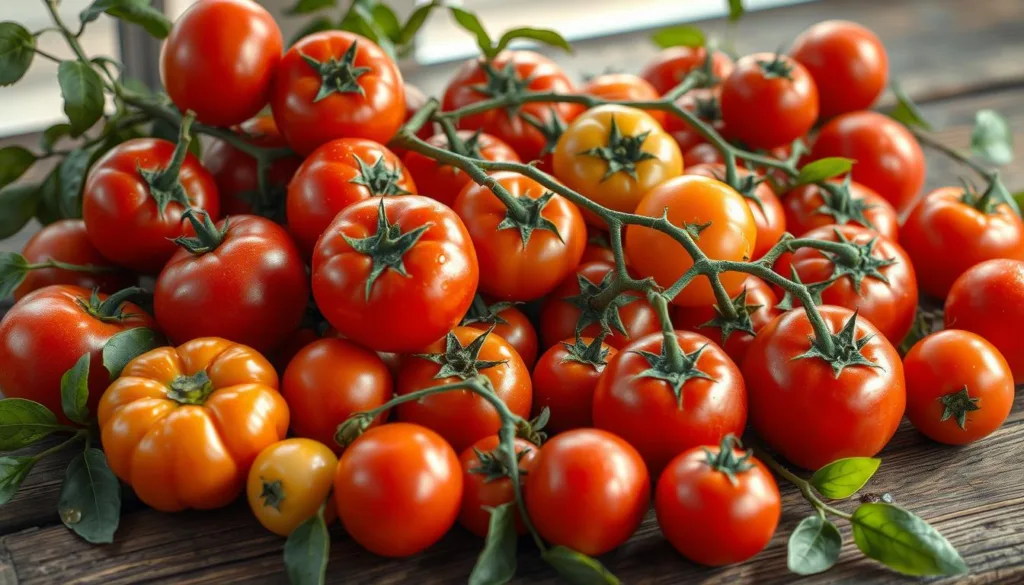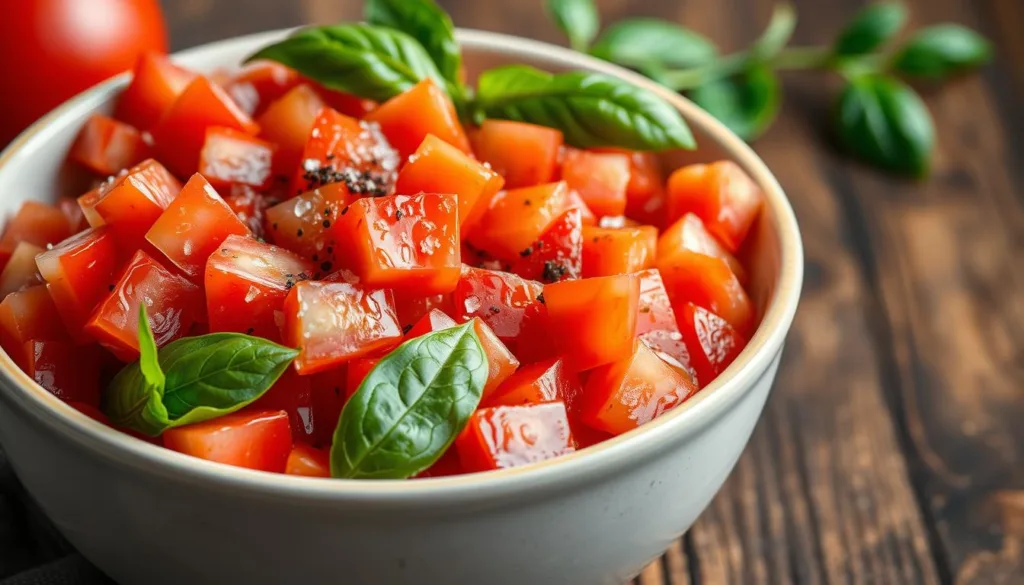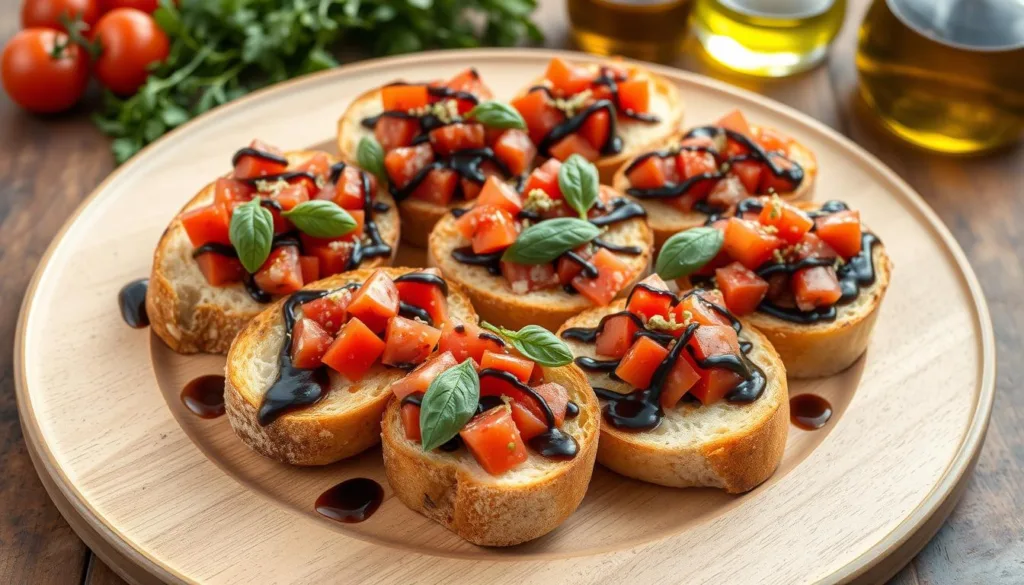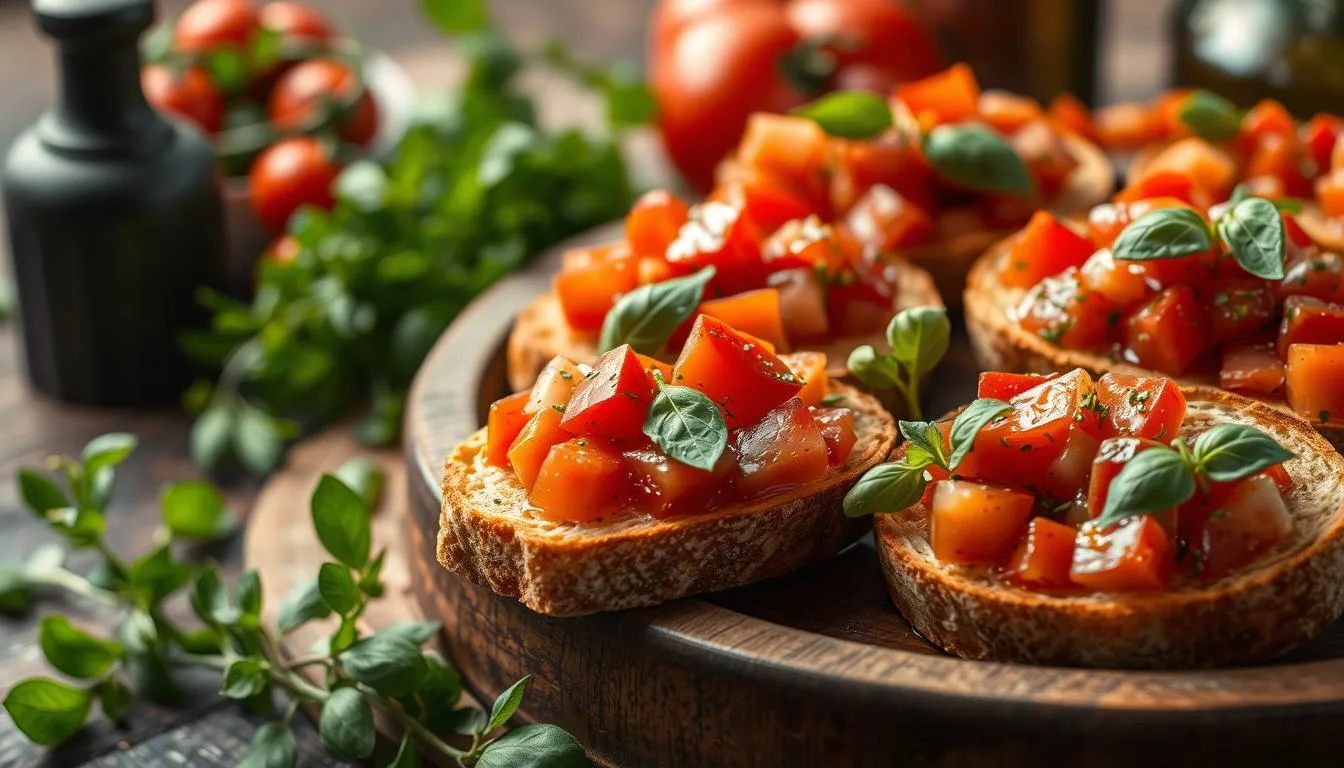I love Italian food and always search for the perfect flavors. Bruschetta is a timeless favorite that always impresses. It’s made with crusty bread, juicy tomatoes, fresh basil, and garlic.
Ever wondered what makes bruschetta so special? This article will cover its history and the secrets to making it perfect. You’ll learn how to create a bruschetta that will wow your guests. Are you ready to learn how to make this Italian favorite?
Key Takeaways
- Bruschetta is a classic Italian appetizer featuring crusty bread, fresh tomatoes, basil, and garlic.
- Mastering the perfect bruschetta requires understanding the history, key ingredients, and preparation techniques.
- Selecting the right bread, tomatoes, and olive oil are essential for creating a truly exceptional bruschetta.
- Proper toasting and assembly methods can elevate a simple bruschetta to new heights of flavor and texture.
- Exploring creative variations and wine pairings can help you customize the bruschetta experience to your taste.
Table of Contents
The History Behind Traditional Italian Bruschetta
The bruscetta, or Italian appetizer, has a long history. It started in ancient Rome. Back then, olive oil tasters used toasted bread to check the quality of olive oils.
Over time, bruscetta changed from a simple tool to a favorite antipasto. It became a key part of Italian meals, with each area adding its own twist.
Origins in Ancient Rome
In ancient Rome, bruscetta was used for olive oil tasting. This simple use helped create the bruscetta we love today.
Evolution into Modern Antipasto
As years went by, bruscetta turned into a cherished antipasto. It became a staple in homes and restaurants, with each area making it their own.
Regional Italian Variations
- In Tuscany, bruscetta is topped with tomatoes, garlic, and basil.
- In Lazio, bruscetta might have roasted peppers, anchovies, or balsamic vinegar.
- In southern Italy, bruscetta can have spicy sausage, sun-dried tomatoes, and olives.
Bruscetta is loved across Italy, with each area adding its own special touch to this classic Italian appetizer.
Essential Ingredients for Perfect Bruscetta
Making a delicious bruschetta starts with the best ingredients. The quality of tomatoes, garlic, basil, olive oil, and bread is key. Let’s look at what makes a bruschetta great.
The tomatoes are the main attraction. Select ripe, plump tomatoes for the most flavorful taste. Cherry or Roma tomatoes are perfect, with just the right sweetness and tanginess. Make sure they’re in season for the best flavor and texture.
Garlic is also crucial. Some like a light garlic taste, while others prefer a stronger flavor. Try both raw and roasted garlic to see what you like best. Minced or grated garlic blends well with the tomatoes.
- Fresh basil is essential, adding a fragrant and herbaceous flavor.
- A drizzle of extra virgin olive oil brings all the flavors together, adding a fruity taste.
- The bread is the base. Choose a crusty, artisanal Italian loaf that can hold the toppings well.
| Ingredient | Ideal Characteristics |
|---|---|
| Tomatoes | Ripe, juicy, and bursting with flavor (e.g., cherry or Roma tomatoes) |
| Garlic | Fresh, with a balance of raw and roasted flavors |
| Basil | Fragrant and herbaceous, freshly chopped |
| Olive Oil | High-quality, extra virgin with a rich, fruity undertone |
| Bread | Crusty, artisanal Italian loaf that can support the toppings |
By choosing and preparing these ingredients carefully, you’ll make a bruschetta that truly captures Italian flavors. Stay tuned for more tips on combining these flavors for the perfect bite.
Selecting the Best Bread for Your Bruschetta
Choosing the right bread is key to making perfect bruschetta. The bread you pick can change the taste and feel of this classic dish. As someone who loves to cook, I’ve found that trying different Italian breads is essential for great bruschetta.
Types of Italian Bread
For bruschetta, popular Italian breads include:
- Ciabatta – A rustic, chewy bread with a crisp crust, perfect for grilling or toasting.
- Baguette – A long, narrow French-style loaf that toasts beautifully and provides a sturdy base for toppings.
- Focaccia – A flat, dimpled Italian flatbread that can be seasoned with herbs and olive oil for added flavor.
- Pane Toscano – A classic Tuscan-style bread with a soft, airy interior and a crisp, golden-brown crust.
Bread Preparation Techniques
Choosing the right bread is just the start. The key to perfect bruschetta is how you prepare it. Slice the bread into 1/2-inch thick pieces, then brush or drizzle them with extra virgin olive oil. This makes the bread crunchy when toasted.
Storage Tips for Fresh Bread
To keep your bread fresh, store it at room temperature in a paper or cloth bag. Don’t use plastic bags, as they can make the crust soft. If you need to store the bread for more than a day, freeze it. Wrap it tightly in foil or plastic wrap to keep it fresh for weeks.
By knowing about different Italian breads and how to store them, you’ll make the perfect toasted bread for your Italian appetizer.
Choosing and Preparing Fresh Tomatoes
Creating the perfect bruschetta starts with choosing and preparing fresh tomatoes. These tomatoes are the heart of this classic Italian dish.
Here are some tips to make your bruschetta recipe a hit:
- Opt for in-season, locally grown tomatoes when possible. They’ll be at their best, full of sweetness and acidity.
- Look for firm, unblemished tomatoes with a vibrant color. Stay away from soft or damaged tomatoes.
- Whenever possible, select a variety of tomatoes in different colors and sizes. This adds both looks and flavors to your bruschetta.
After picking your tomatoes, it’s time to get them ready. Cut them into small, even pieces. Make sure to remove seeds and excess liquid. This keeps your bruschetta from getting soggy. Season the diced tomatoes with a bit of salt and let them sit for a few minutes. This lets the flavors mix before you assemble your dish.

By carefully choosing and preparing your tomatoes, you set the stage for a bruschetta full of fresh, authentic Italian taste. With a few easy steps, you can take this classic dish to the next level.
The Role of Extra Virgin Olive Oil
Extra virgin olive oil is key to making perfect Italian appetizers like bruschetta. It adds a rich flavor and improves the dish’s texture and feel.
Quality Indicators for Olive Oil
To make authentic Italian bruschetta, choose high-quality extra virgin olive oil. Here’s what to look for:
- Aroma and Flavor – Good olive oil has a fruity smell and a balanced taste.
- Color – Its color can vary from pale green to deep golden, depending on the olives and how it’s made.
- Acidity Level – Lower acidity means better quality. Aim for oils with less than 0.8% acidity.
Regional Italian Olive Oils
Italy is famous for its olive oils, each with its own taste. Here are some top picks for bruschetta:
- Tuscan Olive Oil – It’s known for its strong, peppery taste and deep green color.
- Ligurian Olive Oil – It’s light and fruity, with a hint of almond.
- Sicilian Olive Oil – It’s bold and full, with a slight bitterness.
Using the right olive oil from Italy can make your bruschetta stand out. It will impress everyone at your gathering.
Fresh Herbs and Seasonings Guide
Creating the perfect bruschetta starts with choosing the right fresh herbs and seasonings. Basil and garlic are key, adding unique flavors to this Italian favorite.
Basil is a must-have for bruschetta, with its bright green leaves and sweet, peppery taste. Choose the best basil you can find, like from a local market or your garden. Tear or chop the leaves just before using to keep their flavor and aroma.
Garlic is also crucial for bruschetta. You can use raw garlic or roast it for a sweeter flavor. Try different ways to prepare garlic to find what you like best.
Don’t forget to add other herbs like oregano, thyme, or rosemary to make your bruschetta even better. Pick herbs that work well together with the tomatoes and bread.
Keeping your herbs fresh is important. Wash and dry them gently before using. Store them in the fridge or a cool, dry spot to keep their flavor. With a bit of care, you can make a truly delicious bruschetta.
Step-by-Step Toasting Technique
Making the perfect toasted bread for your bruschetta is an art. It’s all about getting a crisp outside and a soft inside. Let’s dive into the steps to make the best toasted bread for your bruschetta recipe.
Grilling Methods
Grilling is a favorite way to toast bread. First, heat your grill to medium-high. Then, brush the bread slices with extra virgin olive oil on both sides.
Put the oiled bread on the grill grates. Let it toast for 2-3 minutes. It should turn golden-brown and get crisp edges.
Oven-Toasting Tips
- Preheat your oven to 400°F (200°C).
- Arrange the bread slices on a baking sheet.
- Lightly brush the tops of the bread with olive oil.
- Bake for 5-7 minutes, flipping the slices halfway through, until the bread is crispy and golden brown.
Whether you grill or bake, aim for a crisp outside and a soft inside. This makes the perfect base for your bruschetta recipe. It lets the toppings stand out.
Creating the Perfect Tomato Mixture
Making the perfect tomato mixture is key to a great bruschetta. I use a few steps to enhance the flavors of tomatoes, basil, garlic, and olive oil.
I pick the ripest tomatoes I can find. Cherry or grape tomatoes are perfect because of their sweetness and flavor. I cut them into small pieces for an even mix.
- Dice the tomatoes into bite-sized pieces.
- Chop the basil leaves into thin strips to release their fragrant aroma.
- Mince or grate the garlic to infuse the mixture with its bold, savory notes.
- Drizzle a generous amount of high-quality olive oil over the ingredients.
- Season with salt and freshly ground black pepper.
Letting the flavors mix is crucial. I toss the ingredients and let them marinate for at least 15 minutes. This way, the tomato juices, basil, garlic, and olive oil blend perfectly, making each bite a delight.

By following these steps, I make a vibrant, flavorful tomato mix. It’s the base for a fantastic bruschetta. The mix of sweet, savory, and herbaceous notes makes every bite memorable.
Garlic Preparation Methods
Preparing garlic for the perfect bruschetta is key. We’ll look at raw versus roasted garlic and how mincing and rubbing affect taste.
Raw vs. Roasted Garlic
Choosing between raw and roasted garlic for your bruschetta depends on taste. Raw garlic is bold, while roasted garlic is sweeter and milder. Think about your bruschetta ingredients to pick the best garlic.
Rubbing vs. Mincing Techniques
There are two main ways to prepare garlic: rubbing and mincing. Rubbing gives a gentle flavor, while mincing adds a stronger taste. Try both to see what you like best.
The way you prepare garlic for bruschetta is up to you. Knowing the differences between raw and roasted garlic, and mincing and rubbing, helps make a delicious bruschetta.
Assembly and Presentation Tips
Making the perfect bruscetta, a classic Italian appetizer or antipasto, is an art. It can make your dishes stand out. Here are key tips to make your bruscetta look and taste great.
Start with how you spread your toppings. Make sure each bread slice has the right amount of tomato mix. This way, every bite is balanced. Don’t overdo it, as too much can mess up the texture.
Adding a garnish is important for looks. A bit of fresh basil or extra virgin olive oil can make a big difference. It not only looks good but also tastes amazing.
Think about how you serve your bruscetta. Instead of just slices, try it on a wooden board or a fancy platter. It makes the dish more inviting and fun to eat.
Bruscetta is great for many events, from casual get-togethers to fancy dinners. With the right assembly and presentation, you can turn this classic Italian appetizer into a stunning dish.

Make-Ahead and Storage Solutions
Preparing a tasty Italian appetizer like bruschetta is easier with planning. Mastering make-ahead and storage ensures your bruschetta stays fresh and flavorful.
Proper Storage Methods
To keep your bruschetta fresh, follow these tips:
- Toasted bread: Store in an airtight container at room temperature for up to 3 days.
- Tomato mixture: Refrigerate in an airtight container for up to 3 days.
- Garlic and herbs: Chop and store separately in the refrigerator for up to 5 days.
- Olive oil: Keep in a cool, dark place away from heat and light for optimal freshness.
Reheating Guidelines
Reheating your bruschetta can bring back its flavors and textures:
- Lightly toast the bread slices in the oven or on a grill for 1-2 minutes to crisp them up.
- Gently warm the tomato mixture in a skillet or the microwave, being careful not to overcook.
- If the garlic or herbs have lost their freshness, you can quickly sauté them in a bit of olive oil before assembling.
By using these make-ahead and storage tips, you can enjoy a perfect bruschetta recipe and Italian appetizer with little effort.
Common Mistakes to Avoid
Making a tasty bruschetta recipe, the classic Italian appetizer, is an art. It needs careful attention. Even skilled cooks can make mistakes. Don’t worry, I’m here to help! Let’s look at the common errors to avoid for delicious bruschetta.
- Overbaking the Bread: Toast the bread until it’s golden brown, not hard. Watch the oven to prevent dry bread.
- Oversaturating the Tomatoes: Juicy tomatoes are great, but too much juice makes the bread soggy. Mix the tomatoes gently and don’t overdo it.
- Skimping on Garlic: Garlic is crucial for bruschetta. Rub the toasted bread with a fresh garlic clove for that special flavor.
- Forgetting the Olive Oil: A drizzle of extra virgin olive oil is essential. It ties all the flavors together. Don’t skip this step!
- Piling on Too Many Toppings: Bruschetta is best when simple. Stick to tomatoes, garlic, and basil. Avoid overloading your slices.
Avoiding these mistakes will help you make perfect bruschetta recipe. Embrace simplicity and let the Italian flavors shine.

Creative Bruschetta Variations
The classic tomato bruscetta is tasty, but it’s even better because you can change it up. This Italian appetizer is a blank slate for new flavors and textures. It lets you explore beyond the usual recipe.
Modern Twists
Chefs are making bruschetta their own, trying new things. They swap tomatoes for roasted red peppers or caramelized onions. They even add figs, brie, or prosciutto for a twist. These new takes make bruscetta exciting for those who love to try new things.
Seasonal Adaptations
Bruschetta is perfect for showing off what’s in season. In spring, it’s topped with fresh herbs like basil and parsley. Summer brings juicy tomatoes and garlic. And in winter, it’s roasted root veggies or creamy butternut squash.
The magic of bruscetta, a classic Italian appetizer, is its endless possibilities. You can go for modern twists or seasonal flavors. Either way, you can make bruschetta your own, with flavors that are both unique and delicious.

